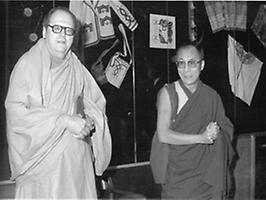Bharati, Agehananda #
eigentlich Leopold Fischer
* 20. 4. 1923, Wien
† 14. 5. 1991, Pittsford, New York, USA
Religionswissenschaftler und Mönch

© Syracuse University
Agehananda Bharati wurde am 20. April 1923 als Leopold Fischer in Wien geboren.
Er wuchs in einem liberal-katholischen Elternhaus auf, besuchte das Akademische Gymnasium und begann sich bereits in der Unterstufe intensiv mit Indien und den indischen Religionen zu beschäftigen.
Ein besonders unangenehmer Katechet, aber auch Erlebnisse mit dem Nazi-Regime, führten dazu, dass er sich vom katholischen Glauben abwandte, formal trat er aber erst nach dem Krieg aus der Kirche aus.
In seiner Autobiographie "The Ochre Robe" (London, 1961) schildert Fischer seine Jugend in Wien, die von seiner Liebe zu Indien geprägt war. Er war das jüngste Mitglied des damals in Wien existierenden Indischen Klubs, wo er sich im Kontakt mit Studenten, Ärzten und anderen indischen Bekannten Kenntnisse mehrerer indischer Sprachen aneignete. Ein Schlüsselerlebnis in Bezug auf die NS-Hysterie nach dem Anschluss schildert Bharati wie folgt: "Am Rathaus hing ein großes Hitlerbild. Davor standen Blumen und Kerzen. Beim Weggehen von diesem Ort bekreuzigte sich eine Frau, bemerkte aber selbst zu ihrem Schrecken, dass sie diese Geste nicht in einer Kirche, sondern bei einer Nazi-Veranstaltung gemacht hatte."
Schon in frühester Jugend stand für Leopold Fischer fest, dass sowohl der Katholizismus wie auch der Nationalsozialismus totalitäre Bestrebungnen hegten. In der mit der Deutschen Wehrmacht verbundenen "Indischen Legion", die sich die Befreiung Indiens von der britischen Kolonialmacht zum Ziel gesetzt hatte, verbrachte Fischer den Zweiten Weltkieg. Er lag am Atlantik, ohne jedoch in Kampfhandlungen verwickelt zu werden. Nach abenteuerlichem Rückzug und viele Monate währendem Gefangeneschicksal im Kreise "echter" indischer Soldaten kehrt er 1947 nach Wien zurück, um an der Universität Wien Orientalistik zu studieren. 1948 erfüllte er sich seinen Traum und reiste nach Indien.
Agehananda Bharati starb am 14. Mai 1991 im Haus eines Freundes in Pittsford, New York.
Seine Stufen auf dem Weg zum Hindu-Wandermönch und später zum international anerkannten Religionswissenschaftler
schildern folgende Berichte:
Now a monk, Leopold Fischer changed his name to Agehananda Bharati. Next, he started a journey across the 1,500 miles of India on foot as a mendicant monk with a beggar's bowl.
Although he attended the University of Vienna, Bharati kept up his studies as a monk and took up teaching as well. Agehananda Bharati's travels were as extensive as his teachings were impressive. He was a professional expert in Cultural Anthropology, South Asian Studies, Linguistics, and Comparative Philosophy. Most of these subjects he taught in Delhi University, Banaras Hindu University, and Nalanda Institute in India. He also taught in a Buddhist Academy in Bangkok, Thailand where he first began his teachings on Comparative Religion.
Bharati became a visiting professor on Indian philosophy in the University of Tokyo and Kyoto. In 1956 Bharati came to the U.S. as a research associate for Washington University. A year later he transferred to Syracuse and joined the anthropology faculty. He settled down in Syracuse and became Ford-Maxwell Professor of South Asian Studies. It wasn't long before he became the chairman of his department. He was granted U.S. citizenship in 1968. Although he lived in Syracuse that didn't mean that he stopped traveling. He managed to go to Hawaii, Britain, Michigan, Russia, Germany, and Ireland for research and as a visiting professor.
Bharati had become a member of numerous organizations including: American Association of University Professors, American Anthropological Association(fellow), Association for Applied Anthropology(fellow), American Linguistic Society, International Association for General Semantics, Mensa International, Mind Association, Royal Anthropological Institute of Great Britain and Ireland, Royal Philosophical Society, Royal Siam Society, International Academy of Human Rights, and New York Academy of Sciences. (Contemporary Authors, 2003)
Agehananda Bharati died on May 14, 1991 in a friend's house in Pittsford, New York. He died of cancer at the age of 68.
In his life, Agehananda Bharati was a warrior, a monk, a student, a teacher, an author, and a traveler. By the time of his death Bharati had over 500 published works, including an autobiography called; The Ochre Robe.
Eine andere biograhische Notiz lautet:
Early in his career, Prof. Bharati became a noted scholar of Indian culture, teaching linguistics, comparative philosophy, anthropology, and South Asian studies at universities and institutions in India, Japan, Thailand, and the United States. In the 1950s, he was a lecturer in German at Delhi University, a reader in philosophy at Banaras Hindu University in India, a guest professor of comparative religion at the Nalanda Institute of Post-graduate Buddhist Academy in Bangkok, Thailand, Asia Foundation Visiting Professor at the universities of Tokyo and Kyoto in Japan, and research associate for the Far Eastern Institute at the University of Washington in Seattle.
Prof. Bharati joined the Maxwell faculty in 1961 as an assistant professor of anthropology. He was promoted to associate professor in 1964 and to full professor in 1968. He chaired the anthropology department from 1971 to 1977 and was acting chair during the spring semester of 1985. In 1991, he was named the Ford/Maxwell Professor of South Asian Studies and also was presented with the Chancellor's Citation for Exceptional Academic Achievement.
An outstanding Sanskritist who spoke 15 classical and modern European and Indian vernacular languages, he is recognized as one of the leading pioneers in the field of tantric studies. He is perhaps best known for his books The Tantric Tradition (The Hutchinson University Publishers, 1966) and The Ochre Robe (Ross-Erikson Press, 1980). Prof. Bharati also wrote hundreds of articles for publications distributed worldwide, was an editor for several international publications, and presented numerous lectures and papers at national and international professional conventions.
References
Narvaez, Alfonso. The New York Times: A Monk Who Served On Syracuse Faculty Pg. 481,1991
Written By: Shauna Arth, 2003
Quellen#
- University of Minnesota
- Syracuse University
![]() Vergleiche hierzu ein ähnliches Schicksal: Muhammad Assad
Vergleiche hierzu ein ähnliches Schicksal: Muhammad Assad
Redaktion: P. Diem